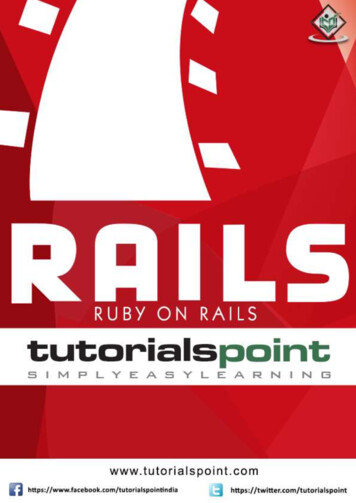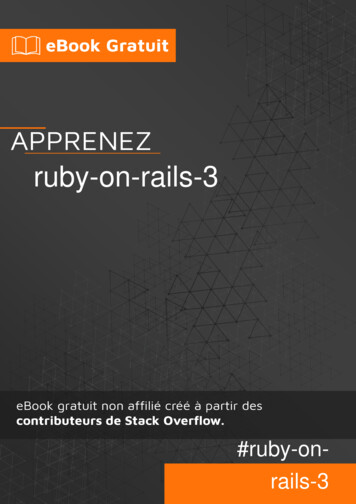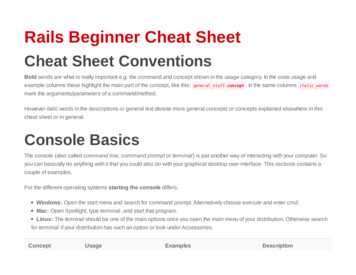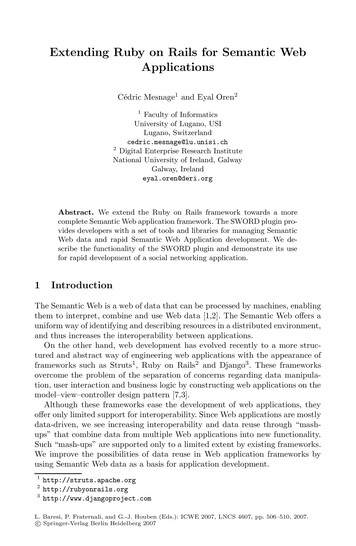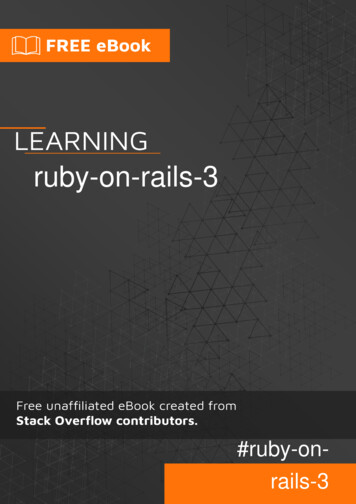
Transcription
ruby-on-rails-3#ruby-onrails-3
Table of ContentsAbout1Chapter 1: Getting started with ruby-on-rails-32Remarks2Examples2Installating Rails on mac.2Hello World in Rails3Credits5
AboutYou can share this PDF with anyone you feel could benefit from it, downloaded the latest versionfrom: ruby-on-rails-3It is an unofficial and free ruby-on-rails-3 ebook created for educational purposes. All the content isextracted from Stack Overflow Documentation, which is written by many hardworking individuals atStack Overflow. It is neither affiliated with Stack Overflow nor official ruby-on-rails-3.The content is released under Creative Commons BY-SA, and the list of contributors to eachchapter are provided in the credits section at the end of this book. Images may be copyright oftheir respective owners unless otherwise specified. All trademarks and registered trademarks arethe property of their respective company owners.Use the content presented in this book at your own risk; it is not guaranteed to be correct noraccurate, please send your feedback and corrections to info@zzzprojects.comhttps://riptutorial.com/1
Chapter 1: Getting started with ruby-on-rails3RemarksThis section provides an overview of what ruby-on-rails-3 is, and why a developer might want touse it.It should also mention any large subjects within ruby-on-rails-3, and link out to the related topics.Since the Documentation for ruby-on-rails-3 is new, you may need to create initial versions ofthose related topics.ExamplesInstallating Rails on mac.You would need to install ruby before you can install rails.Mac already comes with ruby installed based on how recent your macOS is? Depending on whatruby version you want for your development, the best way to install Ruby is to use RVM. In yourterminal, type the command below listed in steps:1. Install rvmcurl -sSL https://get.rvm.io bash -s stable --ruby2. For Rails 3, best version to install is ruby1.9.3rvm install 1.9.3ruby -v # 1.9.33. Set your Ruby versionrvm use 1.9.3 --default4. Install Rails (this rails version requires ruby-version 1.9.3)gem install rails -v 4.2.7.1rails -v # 4.2.7.15. Install railsapprails new my first app #(this will install the app for you.)cd my first apprails s #(run the server)https://riptutorial.com/2
6. Open the browser and type below in your URL.http://localhost:3000Message saying 'Welcome to rails' will be displayed or similar.Hello World in Rails1. Say "Hello", RailsTo get Rails saying "Hello", you need to create at minimum a controller and a view.A controller's purpose is to receive specific requests for the application. Routing decideswhich controller receives which requests. Often, there is more than one route to eachcontroller, and different routes can be served by different actions. Each action's purpose is tocollect information to provide it to a view.A view's purpose is to display this information in a human readable format. An importantdistinction to make is that it is the controller, not the view, where information is collected. Theview should just display that information. By default, view templates are written in a languagecalled eRuby (Embedded Ruby) which is processed by the request cycle in Rails beforebeing sent to the user.To create a new controller, you will need to run the "controller" generator and tell it you wanta controller called "Welcome" with an action called "index", just like this: bin/rails generate controller Welcome indexRails will create several files and a route for rs/welcome controller.rbget me/index.html.erbtest unittest/controllers/welcome controller test.rbhelperapp/helpers/welcome e.coffeescssapp/assets/stylesheets/welcome.scss2. Most important of these are of course the controller, located atapp/controllers/welcome controller.rb and the view, located atapp/views/welcome/index.html.erb.Open the app/views/welcome/index.html.erb file in your text editor. Delete all of the existingcode in the file, and replace it with the following single line of code:https://riptutorial.com/3
h1 Hello, Rails! /h1 3. Now that we have made the controller and view, we need to tell Rails when we want "Hello,Rails!" to show up. In our case, we want it to show up when we navigate to the root URL ofour site, http://localhost:3000.Next, you have to tell Rails where your actual home page is located.Edit the file by addingthe line of code root 'welcome#index'. It should look something like the following:Rails.application.routes.draw doget 'welcome/index'root 'welcome#index'end4. root welcome#index tells Rails to map requests to the root of the application to the welcomecontroller's index action and get welcome/index tells Rails to map requests tohttp://localhost:3000/welcome/index to the welcome controller's index action. This wascreated earlier when you ran the controller generator (bin/rails generate controller Welcomeindex).5. Yay, now the moment of truth. Launch web server after restarting your rails server andnavigate to http://localhost:3000 in your browser. You'll see the "Hello, Rails!" messageyou put into app/views/welcome/index.html.erb, indicating that this new route is indeed goingto WelcomeController's index action and is rendering the view correctly.This Guide is from guides.rubyonrails.org. Happy Hacking!Read Getting started with ruby-on-rails-3 online: orial.com/4
CreditsS.NoChaptersContributors1Getting started withruby-on-rails-3Community, TheMouseManhttps://riptutorial.com/5
This section provides an overview of what ruby-on-rails-3 is, and why a developer might want to use it. It should also mention any large subjects within ruby-on-rails-3, and link out to the related topics. Since the Documentation for ruby-on-rails-3 is new, you may need to create initial versions of those related topics. Examples

